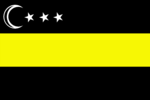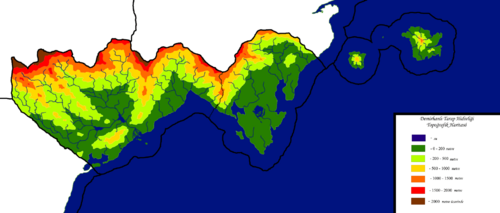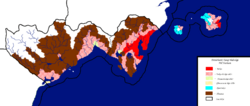Demirhan Tarephian Khedivate
Loading map... |
Demirhan Tarephian Khedivate (tr. Demirhanlı Tarap Hidivliği) - autonomous overseas territory of Demirhan Empire located on lower part of Eastern Tarephian Peninsula. Divided into three provinces of Vilayet rank, is led by a Khedive (viceroy) who is responsible only to sultan and Grand Vizier. The territory covers area of 107 thousands squere kilometers of which land area is 75 thousands. The capital of the khedivate is Yeşilkörfez, which is also the largest cities. The territory borders countries of Eden and Arbutania.
The territory was part of several native Tarephian empires until it was conquered by pirates allied with Demirhan Empire. After the conquest it was integrated with the rest of the country, first as a colony and later a khedivate with wide autonomy. While in first years conflicts between natives and Imani migrants were quite intense, often leading to acts of bloodshed and violence, later both parts of the society learned how to live and tolerate each other. When the inhabitants of khedivate received equal citizenship rights the proces of full integration has begun and now the standards of living in the territory are comparable to rural parts of core Demirhan Empire.
Khedivate is important producer of tropical food and mining centre of several rare minerals like lithium or molybdenum. Sugar Cane Islands are also important tourist hub.
Geography
The territory is relatively flat, except for small mountains with present volcanic activity forming its northern border and hills near the western coast. The shores are covered with mangroves transforming into lush jungle in the western part of the khedivate. Eastern part, densely inhabited farming area, is dominated by large and swampy Manatukuk Lake in Storm Peninsula. Volcanic activity is present in Sugar Cane Islands, also the mountains are formed from inactive volcanoes.
Climate of the territory is mainly tropical with noticeable dry and wet seasons. Temperatures are high for most of the time.
| | |
|---|---|
| Birth: 11th September 1683, Hanif | Death: 12th April 1739, Yeşilkörfez |
| Other names: Alaeddin Reis, Diabo Vermelho | |
| Reis, Kapudan Paşa | |
| Demirhani pirate of Turquese origin, born and raised in Hanif, Mazan by his parents who went to pilgrimage to Maad and could not afford returning to homeland. His first activity was recorded near Mazanic and Adenian coast. In 1707 he was forced to flee from the area by Mazanic military and decided to settle in Sugar Islands. He quickly subjugated the natives, converted them to Iman and enlisted them to his crew. In 1711, because of being endangered by invasion of world powers interested in the region, he asked sultan Ibrahim II for protection. As a result received the title of pasha and an order to expand to mainland. Conquered vast amounts of land and made his base in Yeşilkörfez, died while defending his domain in minor clash with Florescentans. | |
History
Khedivate was established in 1711 by acquiring by Demirhan Empire a short-lived pirate state of Sugar Islands. After that with support of imperial army, former pirate leader Alaeddin Pasha was sent to mainland to conquer land in lower part of the Nukançikipa Peninsula, occupied by Inti Empire. The state, controlling most of the peninsula, was, despite the name, more a confederation of small states rather than centralised organism so Alaeddin was able to use tricks to take control over some areas without actually fighting with entire country. When central government of Inti Empire started to gather the army, small group of Demirhani soldiers were sent to Kumirt'uku where the emperor Samiyuk resided and killed him. As the soldiers had fake evidence showing that they were paid by one of the most ambitious chieftains, the murder escalated into civil war. Seeing the success of his plot, Alaeddin Pasha started to offer his protection to local governments and people, showing himself as a peacemaker instead of invader.
As a result most of the country fell into his hands soon, although some of chieftains from western part of the country preferred Florescentan protection which led to years long conflict between Demirhanis and Florescentans. Despite that inconvenience, Alaeddin demanded from the sultan hereditary position of Khedive. While initiallly the capital was unwilling to grant him such privileges, engagement in wars with Aryan Empire, forced sultan to accept Alaeddin demands and autonomous khedivate was established over Tarephia.
Alaeddinid dynasty
Alaeddin Pasha wanted to increase his power even further and soon became engaged in wars with neighboring colonies. Initially successful, he was able to capture large are around the town of Hörizonte from Florescentans. However soon the tides had turned and wounded Alaeddin returned to Yeşilkörfez where he died. His son, Orhan took the position of khedive under permission of sultan Mehmet IV. Unlike his father he was not born with a sword in hand and instead laid fundations for proper organisation of the territory and secured it's borders by signing a treaty with local Florescentan rulers.
In internal politics he developed many mosques and madrasas, speeding up local people conversion to Iman and teaching them Turquese and Mazanic. That led to diminishing role of local chieftains in the society, resulting in centralisation of power in Yeşilkörfez. As a result, peace-loving khedive was forced to face rebellion led by chieftain known widely as Çuran Ağa. In 1754, after nearly two years Çuran was killed and rebellion stopped. Orhan understood that ruling a country with only a few loyal men is dangerous and destined to fail. He decided to bring more settlers from mainland Demirhan Empire. The offer was, however, attractive only to poorer inhabitants of the empire, coming mostly from newly acquired Şirvan. Waves of Aryans, including many people with shady political past arrived to Tarephian Khedivate, and many of them quickly found comfortable place as local governors.
After Orhan's death, Aryans increased their influence even more, forcing khedive Ahmet to seek independence from Demirhan Empire. Being aware of their plans, sultan Abdülhamid II in 1808 decided to remove Ahmet from the office. Khedive initially denied but accepted the demand when large fleet left Neril to Yeşilkörfez. Since then Tarephian khedive became to be non-hereditary title and most of the autonomy was removed.
Province of Demirhan Empire
Most important task for several next khedives was diminishing influence of Aryan elites. They used to seek support among local people but both Apurimaks and Illimans were not enough to resolve problems. Demand for workforce in mines and plantations also exceeded the capacity of the local population. The only choice was to seek another migrants. Several campaigns in mainland empire were unsuccessful so khedives were allowed by Grand Vizier to seek them in other Imani lands. Call for migration in Mazan and Aden remained with little to no answer as well but was welcomed warmly in Majesia. As a result of this migration, Majesians and Walleans remain fifth largest ethnic group in the country, after Ilimans, Turquese, Aryans and Apurimaks.
Imperial constitution of 1916 brought reorganisation of the country into three vilayets. It also guaranteed Apurimaks and Ilimans, as constitutional ethnic groups right to be educated in their languages and allowed their public display which led to cultural revival. This brought topic of neo-paganism into prosperity, leading to reopening of some old temples and even establishing new which caused heavy criticism from local imams, especially after the March incident. On 21th March 1955 people gathered in the temple in Sillayuk for a Spring festival. The leader of the cult asked them to drink special drink made of local toxic plants to make the Virakoça come and resurrect the Inti Empire to its old glory. As a result of intoxication 317 people died causing countrywide discussion about permission for pagan practices as being deadly and nationalistic at the same time, however with little reaction from central government. However, pagans, along with Antharians and Hellanesians, became one of main targets of fascist government from years 1963 - 1991. Temples got closed in 1968 and soon after that many cult leaders disappeared. The situation went back to normal after death of Süleyman III in 1991 but paganism never fully regained popularity from nearly fifty years before.
Politics
 See also: Government of Demirhan Empire
See also: Government of Demirhan Empire
The leader of the territory is a khedive who is also a governor of Fırtına Byrnu Vilayeti. The position makes him superior to governors of two other vilayets. In modern times khedive is appointed by the Sultan, usually from government officials from the khedivate. The khedive is free in forming his own local government which, however, usually has relatively small size.
As a form of democratic representation in governance, along typical vilayet councils the special Khedive divan (Hidiv divanı) is formed. Composed of 64 members the council can issue laws of the lower rank. Historically most of the council members were elected from old ruling class but in modern times it got easier for other people to enter the council. However, despite citizens are free to join parties and organize political activities, the council remined mostly free from influence of political parties. Currently only 12 councilors are members of political parties: 3 from GİP, 2 from RP, 1 from FP and the latter 6 from local Happy Khedivate Party (Mutlu Hidivlik Partisi).
When it comes for international politics, the khedivate is fully dependent on Demirhan Empire, however several consulates, mostly from neighbouring nations operate in Yeşilkörfez.
Administrative divisions
 See also: Description of imperial subdivisions
See also: Description of imperial subdivisions
Khedivate follows standard set of subdivisions from Demirhan Empire, that means territory is divided into three vilayets which are later divided into sanjaks and kazas.
Economy
 See also: Economy of Demirhan Empire
See also: Economy of Demirhan Empire
Three main factors of khedivate economy are agriculture, mining industry and tourism. Most important crops include sugar cane, tobacco, coffee beans, rice.
Mineral resources include lithium and molybdenum, followed by gold and silver. Small amounts of iron and copper is also produced although only lithium and molybdenum can be treated by local industry.
As continental part of the khedivate has shores mostly covered in mangroves Sugar Cane Islands are main tourist destination followed by the capital - Yeşilkörfez.
Society
Structure of society of the khedivate is much simpler than the one of core part of the empire. The main groups are described in the table below.
| Name | Presence | Population | Main religion | Additional info |
|---|---|---|---|---|
| Turquese | All of the territory, mostly in the east | 1 688 348 (51,28%) | Iman | The dominant group from which comes the ruling dynasty, Turquan language is also the only official language of the entire country. |
| Aryans | Between Kumırt'uku and Şirinabad | 338 465 (10,28%) | Iman | Relatively large population of Aryans was brought to the khedivate after wars with Aryan Empire. |
| Illimans | Entire Tarephian part | 984 760 (29,91%) | Iman, native Illiman | Illimans were once the only inhabitants of the continental part of the country. |
| Apurimaks | Sugar Cane Islands | 117 124 (3,56%) | Iman, native Apurimak | Apurimaks were once the only inhabitants of Sugar Cane Islands |
Other minorities constitute 4,98% of territory population. Most of them are descendants of Walleans and Majesians brought to work on sugar cane plantations and, in the far west, remnants of Florescentan settlers. Other notable groups include Lorantians, Hellanesians and Ivirans.
Religion
The main religion of the territory is Iman religion of Mazanic Sect, influenced, similarly to core part of the empire by various domestic philosophies to the point that, especially in versions mixed with native Illiman beliefs may be considered separate religion or a clear heresy. About 92% of inhabitants of the territory follow that form of Iman. 7,7% follows local Illiman religion and 0,3% follows Apurimak native beliefs. Atheism, in the same spirit as in the core part of the empire, is banned but it is estimated that at least 12% of the population does not practice any religion.
Territory-specific topics
| ||||||
Regional topics
| ||||||
Global topics
| ||||||



